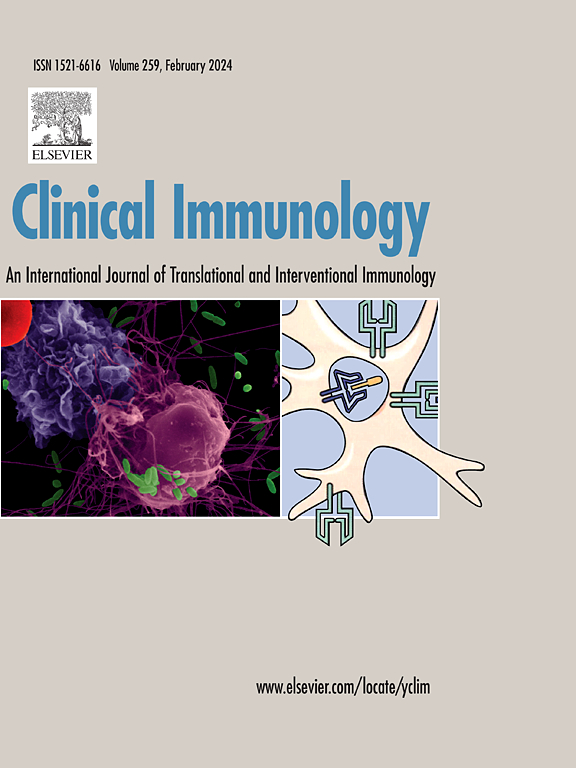两个患有高IgE综合征的家族因深部内含子变异导致DOCK8缺乏症。
IF 3.8
3区 医学
Q2 IMMUNOLOGY
引用次数: 0
摘要
细胞发生器 8(DOCK8)缺乏症是大多数常染色体隐性型高免疫球蛋白 E 综合征(HIES)患者的病因。大多数 DOCK8 基因突变涉及缺失和剪接接头突变,这些突变会削弱蛋白质的表达。不过,也有少数患者的表现让人联想到 DOCK8 缺乏症,但却没有可识别的突变。通过全外显子组测序(WES),我们在两名具有 HIES 特征的非亲缘关系患者中发现了一个位于 36 号内含子(c.4626 + 76 A > G)的深内含子同源 DOCK8 变异,该变异导致 DOCK8 cDNA 中出现 75 个碱基对的内含子序列插入,导致一个过早的终止密码子(p.S1542ins6Ter)。这种变异导致 DOCK8 表达的不同程度下降,而这种下降与 T 细胞受体触发的肌动蛋白聚合受损、IL-6 诱导的 STAT3 磷酸化下降、Th17 细胞标志物 CCR6 和 IL-17 表达下降以及表明 Th2 偏向的 GATA3+ T 细胞频率升高有关。我们的方法扩大了 WES 在鉴定与疾病相关的内含子变异方面的应用范围。它突显了非编码突变在免疫缺陷疾病(包括 DOCK8 缺乏症)中的作用,并强调了在无法解释的先天性免疫错误中探索这些突变的必要性。本文章由计算机程序翻译,如有差异,请以英文原文为准。
DOCK8 deficiency due to a deep intronic variant in two kindreds with hyper-IgE syndrome
Dedicator of cytokinesis 8 (DOCK8) deficiency underlies the majority of cases of patients with autosomal recessive form of the hyper-immunoglobulin E syndrome (HIES). Most DOCK8 mutations involve deletions and splice junction mutations that abrogate protein expression. However, a few patients whose presentation is reminiscent of DOCK8 deficiency have no identifiable mutations. Using Whole Exome Sequencing (WES), we identified a deep intronic homozygous DOCK8 variant located in intron 36 (c.4626 + 76 A > G) in two unrelated patients with features of HIES that resulted in an in-frame 75 base pair intronic sequence insertion in DOCK8 cDNA, resulting in a premature stop codon (p.S1542ins6Ter). This variant resulted in variable decrease in DOCK8 expression that was associated with impaired T cell receptor-triggered actin polymerization, decreased IL-6-induced STAT3 phosphorylation, reduced expression of the Th17 cell markers CCR6 and IL-17, and higher frequencies of GATA3+ T cells indicative of Th2 skewing. Our approach extends the reach of WES in identifying disease-related intronic variants. It highlights the role of non-coding mutations in immunodeficiency disorders, including DOCK8 deficiency, and emphasizes the need to explore these mutations in unexplained inborn errors of immunity.
求助全文
通过发布文献求助,成功后即可免费获取论文全文。
去求助
来源期刊

Clinical immunology
医学-免疫学
CiteScore
12.30
自引率
1.20%
发文量
212
审稿时长
34 days
期刊介绍:
Clinical Immunology publishes original research delving into the molecular and cellular foundations of immunological diseases. Additionally, the journal includes reviews covering timely subjects in basic immunology, along with case reports and letters to the editor.
 求助内容:
求助内容: 应助结果提醒方式:
应助结果提醒方式:


